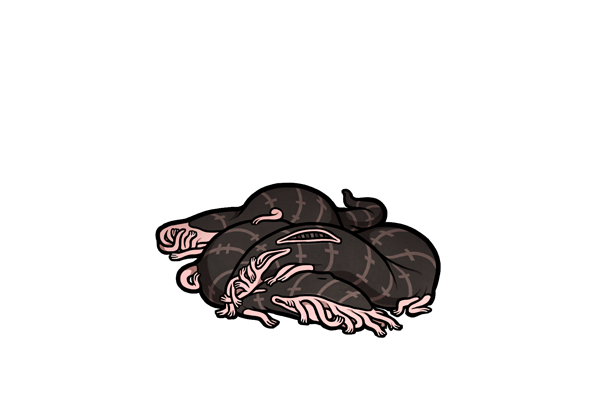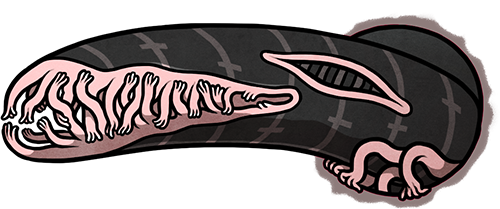

zibranidrele
the small trials
prefix zibrani suffix drele
zivicou schrein
physical appearance
The zibranidrele /zɪˈbɹænɪdriːl/ is a black stranger with pink, stitch-like stripes across its body. It has dozens of arms on its underside, lining its mouth, and within its body cavity (which curl around each other tightly). Its physical form is rather vulnerable, and it is killed by exposure to extreme cold or heat. Its skin is smooth and soft to the touch, while its flesh is pink and gummy. Although its skin repels water, the zibranidrele drowns in seconds when submerged. It heals itself with great difficulty, and often with noticeable scarring.
The zibranidrele emits a slight churning sound as it moves. Its voice is whispery and barely audible, and it possesses no language of its own, but instead repeats single words it overhears in its environment. It struggles to pronounce these words correctly, and often must repeat a word hundreds or thousands of times before it is able to reproduce it with any level of accuracy, with its "tongue" being its greatest impediment.

above: closeup of head and unique "teeth".
Each zibranidrele can have a lexicon of between 5 and 35 words, but is unable to string together sentences, and must have a period of silence between each verbal utterance.
Bats.

environment and generation
The zibranidrele appears in small cavities between the floors of buildings, where it starts off as a small, worm-like shape, which grows larger over the course of several minutes, suddenly sprouting arms in the last moments of its growth. As a social stranger, zibranidrele simultaneously generate in large groups, wriggling from these piles like exploratory maggots.
Up to a quarter of all individuals appear in cavities from which they cannot escape, and spend their entire shortened lives writhing and struggling in place, before they pass away in an abrupt spasm, their bodies withering to nothing. In less than one percent of generating zibranidrele, shoebox-sized cavities may even host small clusters of such unfortunate individuals, which, compressed within such a tight space, turn black and die almost immediately upon generation. Despite the lethality of these locations, these clusters have a tendency to persist, and waves appear and die one after the other for several months at a time before stopping.
behaviour
The zibranidrele possesses a nervous, cautious disposition. It scampers from place to place with hurried, scrabbling movements, and avoids large, open spaces. It creates tunnels by scratching at surfaces around it, and occasionally its own body, as though afflicted with an intermittent, but persistent itch. It sometimes grabs and drags small objects it finds, but this appears to be a largely involuntary action, perpetuated by reflex and not interest. When it falls or is flipped over onto its back, it writhes, curls, and uncurls is body, appearing to have some level of difficulty righting itself.
The zibranidrele corners and kills any small rodents, insects, or other vermin it encounters, picking them apart with its dozens of small, tiny hands, and scattering these pieces throughout its tunnels. A zibranidrele's tunnels can often be identified by the many insect parts, mouse bones, and wadded-up spiderwebs that line their walls.
The zibranidrele is social within its own group, and works with its companions to build complex networks of tunnels and chambers beneath the floorboards under which it lives. Despite this gregarious nature, zibranidrele display outright aggression towards other groups within their strain, and groups always fight each other when two or more occur within in the same general area. In addition, the zibranidrele appears capable of using small pebbles, nails, or pieces of wood to block off other groups' tunnels.
interactions with sensitives
The zibranidrele moves away from and seeks shelter from any loud sounds or sudden movements. As a result, it tends to avoid most sensitives. Unmoving sensitives, however, are a source of idle curiosity. A curious zibranidrele has been known to pull on hair, grab and pick at any dry or flaking skin, or pull up fingernails. All the same, even the slightest movement causes it to scurry away, and it writhes and struggles in frantic terror when held.
sensations of itching
The zibranidrele's close presence causes both sensitives and non-sensitives to feel an itching sensation across their entire body, the intensity of which is dependent upon the number of zibranidrele nearby. Although one zibranidrele causes only a barely noticeable tickling sensation, large groups of zibranidrele (20-30 individuals) cause a burning itch that covers every inch of the body, including the inside of the throat and the surface of the eyes.
Clusters of zibranidrele sometimes congregate beneath the beds of sleeping sensitives, who are only afflicted with itching upon waking.
aging and death
As the zibranidrele ages, it scratches itself more and more, until this behaviour becomes so relentless as to become injurious. It eventually causes fatal wounds to itself, and dies with a shrill whimper, its corpse curling up like a millipede. Its dead body then dries out, shrinks in size, and hardens into a dark grey, leathery mass over a period of several days. Other zibranidrele move these corpses to the sides of their tunnels and press them firmly against the wall before moving on.



